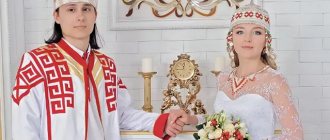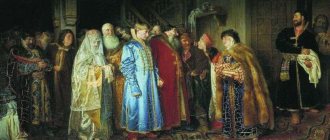The culture of each nation is unique and inimitable in its own way. The traditions and beliefs that determine the way of life of different ethnic groups, even within the same country, can differ dramatically. They agree on one thing: the birth of a new family is always celebrated on a grand scale, and the wedding itself is preceded by a long preparatory period. Rituals carried out during marriage celebrations are aimed at increasing the welfare of the newly created family and the birth of healthy, numerous children. An Udmurt wedding is a bright event in the original folk style, carried out in compliance with national beliefs and customs.
Ancient marriage traditions of the Udmurt people
The Udmurts are a small ethnic group living in the Kama region. The first tribes appeared in this territory ten thousand years ago, and written sources about the Udmurts go back a thousand years. This people carefully preserved their original way of life. Despite the influence of the culture of other peoples and the Orthodox faith, many rituals have been observed since pagan times to this day.
Modern life makes its own adjustments; this cannot be avoided. Udmurtia, like all republics of the Russian Federation, keeps pace with the times. Some customs are outdated and almost forgotten; only ethnographers and old people from remote villages remember them. Something has lost its meaning, discarded as unnecessary. But the time-honored basis of the marriage ceremony is revered and strictly observed. The ritual of the unity of a man and a woman to create a new family reveals the unique flavor of primordially Udmurt customs.
Despite the pagan roots, the influence of the Orthodox faith on the culture of the Udmurts is great. Weddings in Udmurtia , as a rule, were timed to coincide with major Christian holidays. The summer period was considered an extremely unfavorable time for marriage; work in villages in the summer was no end of the land.
As soon as the harvest was over, weddings began to thunder in all villages, this time is from mid-October to mid-November. Getting married during this period was considered the most favorable omen. The wedding, blessed by the abundant harvest of the past year, promised a prosperous, satisfying life and numerous offspring. And in winter it was customary to get married, starting from Epiphany, January 19, until the spring Maslenitsa. Wednesday, Friday and Sunday were considered forbidden days.
A feature of the ancient Udmurt wedding is the long breaks between stages of the ceremony. Often, they lasted for several months. In this unusual way, families and those getting married themselves were given time to gather their courage and prepare for the next complex action in a whole series of rituals.
Food
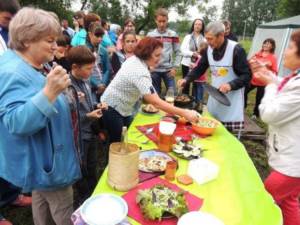
Thanks to well-established agriculture, the people of Udmurtia managed to obtain a variety of crops. People have always eaten food rich in minerals, vitamins, proteins, and microelements. The cuisine of Udmurtia is rich in cereals and legumes. Jelly is made from peas, koloboks are baked, and soups are made. Even children love peas, because they are a delicacy in Udmurtia - they are fried and candied. Compliance with traditions and a long-standing way of life are national features of Udmurt cuisine. As in ancient times, radishes, carrots, rutabaga, and cabbage are added to dishes here. The dough of the pies may seem bland - this is a specific feature of the flour dishes of the local cuisine. Bread is baked using rye and wheat. Bakery products are always held in high esteem. Tabani are considered the most beloved. These small sour dough cakes are devoured on both cheeks. Tabani is served with melted butter and sour cream, and sometimes salted cottage cheese is added. On a summer day, such a flatbread will be eaten with berries. Tabani is never consumed cold. The flatbread is only good when it is hot. Udmurt dumplings can be considered the most diverse dish. There are many recipes that delight you with their ingenuity. The filling can be almost anything: lamb, pork, radish, mushrooms, cottage cheese. Everything is limited only by the chef's imagination. Udmurts often stock up on dumplings for future use in winter. Many residents believe that they were the first to invent dumplings. In Izhevsk there is even a monument dedicated to dumplings. Perepechi is served on the holiday - this dish is somewhat reminiscent of pasties. The filling can include potatoes, radishes, cabbage, mushrooms, and chicken eggs. The most popular drink is sur. This is Udmurt kvass, to which hops, anise, and birch leaves are added. Sur is prepared with rye flour. It is also used for preparing bread moonshine.
The Udmurts are a rich people in every sense. Their unique culture attracts people from all over the world, so it is not surprising that the number of tourists seeking to visit the republic is constantly growing. Preserving a traditional way of life is certainly a strange phenomenon these days. That's why so many people come here to see how one of the oldest peoples lived.
Bride selection period and matchmaking
All issues regarding dating and marriage were decided by older family members. Girl brides who had reached marriageable age did not have the right to vote. Often, no one asked the young groom either. They started looking for a bride for their son when he turned 13-14 years old, and the most suitable age for marriage was considered 16-18 years old. The future wife had to be healthy, hard-working, calm in character, and not crippled.
The girl's skills and abilities were carefully assessed, as well as the well-being of her relatives and the amount of the dowry. There should not be any damaging rumors about the girl. Very often the bride was 2-6 years older than the groom. The reasons for such decisions are purely practical: the farm needed workers. A teenage girl still needed to be trained, but it is unknown what kind of housewife she would have made. However, the girls’ parents were in no hurry to marry them off - all for the same reasons.
Relatives and acquaintances were actively involved in the search for a suitable candidate. Recommendations could be given, if necessary, by mature married ladies who carefully studied potential brides. Such women were called demchi - matchmakers. Recognized demchi provided comprehensive information on the candidates, including their character, preferences, integrity, hard work, a complete description of all relatives, as well as their income.
As soon as the candidacy was approved by the family council, preparations were made for matchmaking. The matchmaker was the groom's father, the demchi, and selected members of the immediate family. The matchmaker started the conversation, using colorful allegories, and sometimes even in poetry, describing the merits of such a successful match for their daughter. But the bride's parents remained steadfast. No one was able to get a positive answer right off the bat.
The unsuccessful matchmakers took their leave, forgetting something of their clothing, usually mittens or a belt. They returned for the loss a few days later and started the same song again. Sometimes I had to “forget” five or six times. When the bride's relatives finally came to terms with the thought of a quick farewell to their little blood, a samovar heated by the bride and fragrant tea awaited the driven matchmakers.
If the relatives categorically did not agree to the proposed party, the girl defiantly pulled the tablecloth off the table, running out of the house.
It was at the table that the size of the yyrdon, the bride price, the dowry of the chosen beauty and the accounting of joint expenses for celebrations were discussed. Long and very difficult negotiations ended in mutual agreement, when the smallest details, down to the bride’s attire and the number of towels in the dowry, were taken into account.
The matchmaking ended with a presented loaf with a bowl full of butter on it. This right was usually granted to the mother of the bride or the eldest woman in the house. A representative of the happy groom threw silver coins into the oil, marking the girl's transition to the status of an official bride.
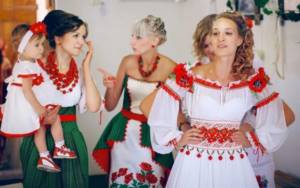
Udmurts and matriarchal system.
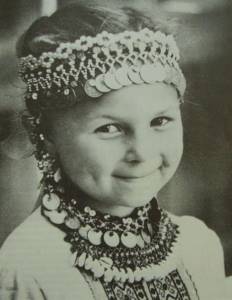
Let's agree this - I'm not a historian. There are many materials on the presented topic and there are different theories. I will present to you the opinions of various researchers (I will indicate all the sources) and the personal experience of my family. The Udmurts are the indigenous Finno-Ugric people of the Volga and Cis-Ural regions. The Udmurts are currently settled quite compactly. The bulk of them live on the territory of the Udmurt Republic (410 thousand people) and in adjacent territories.
The female world in Udmurt culture is an extremely important phenomenon. It was the woman who for centuries was the keeper of traditions and spiritual values of the entire family. The woman was the embodiment of nature itself with its eternal cycle of life: birth, life, death and rebirth again.
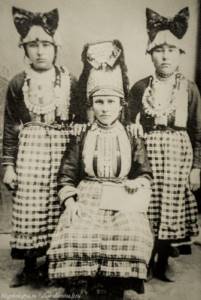
Religion. Early forms of religion were based on the cult of the female mother. In the worldview of the Udmurts, a special place was occupied by supernatural beings with the feminine principle of the Great Mother (Ancestral Goddess, Foremother Spirits).
Later myths of the Udmurts (or Votyaks) reflected the ideas of neighboring Turkic-speaking peoples. Classic male images appear: God - Inmar - Lord of the Sky and the Devil - Vukuze - Vodyanoy. And also the deity Kyldisin - the spirit of the earth, fertility, which had both a feminine (Mother Earth) and a masculine principle.
According to one of the legends, the earth was created by the Swan (this is a female image, there is even an ancient female name Yusch - swan), who pulled the earth in her beak to the surface of large waters. This swan girl is even on the coat of arms of our republic.
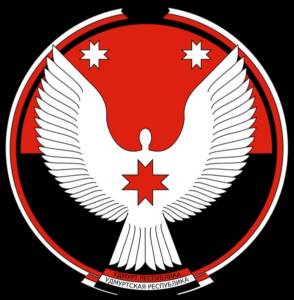
They addressed the sun (Shundy-mumy), the moon (Tolez-mumy), the earth (Muzem-mumy), the water (Wu-mumy) - mums - i.e. mother. These images were female.
The period of matriarchy. I did not find any contradictions among scientists in the fact that initially the Udmurt society was matriarchal. This historical period is called the Epoch or Period of Matriarchy. The founder of the clan was considered to be a female foremother (tribal deity Vorshud). The entire clan was named by her totemic name (something like a surname). The clan kept records through the female line, i.e. When a woman got married, she did not take her husband’s “surname”; the husband was part of her clan.
The most important member of the family was the oldest woman. The German scientist M. Buch (the first scientist whose work in the field of studying the Finno-Ugric peoples was the most fundamental) noted that the Udmurts highly valued the status of women, and her opinion was decisive on almost all issues.
Reasons for the establishment of matriarchy. The works of M. O. Kosven are related to women's themes. The researcher paid close attention to agricultural labor, as well as the role and primacy of the Udmurt woman in society. It was agriculture and the products of agricultural labor, which were controlled by women, that led to the fact that women began to personify the economic state of society. At the same time, the researcher believed that the woman’s high mortality rate was facilitated by her high labor activity compared to Udmurt men.
A sedentary lifestyle in remote regions gradually led to the decline of male industries (hunting, fishing, beekeeping).
Archaeologists found large storage pits-pantries that belonged to the clan, in which supplies were stored, indirectly determining the status of the member of the society involved in distribution - the woman. In this regard, with the ever-increasing social and economic role of women in the social and public sphere, there was a flourishing of the maternal clan community and the formation of a way of life in which a woman became the owner (proprietor) of clan lands, territories, fishing and hunting grounds, as well as belonging to the type of means of production.
Family rituals. The archaic and traditional nature of Udmurt culture, in which the role of women was decisive, is most clearly manifested in wedding rituals. In wedding rituals, the echo of the Udmurt matriarchy is most clearly heard. A woman in the status of a bride was considered an ideal in ancient Udmurt society. The Udmurts never had a tradition of “ransom” - a girl was not considered a commodity or property. There was no problem with forced marriage, women were not forced to marry without their will (According to some sources, the picture was even the opposite - the bride was most often a little older and had more freedom of choice than the grooms).
The burials were separate. In early periods, women's burials contained more valuables than men's, as well as objects symbolizing the family lineage. Later, after the adoption of Christianity, the burials became the same.
Christianity. The adoption of Christianity became very painful for the pagan Udmurts, and was not completely rooted in consciousness. Even now I see strange rituals in villages, mixed with Christianity and the cult of the harvest, for example. Everything mixed up and turned into a strange form, where baptized people celebrate ancient pagan holidays along with church holidays, and the images of saints merge with traditional pagan gods. For example, my eldest aunt (she is 83 years old) will never exclaim: “Oh, my God!” She will say: “Inmare! (Lord of the Sky)"
The policy of forced Russification is the implantation of Christianity among the pagan Udmurts.
Udmurts who converted to Christianity were exempt from conscription. They were given tax breaks. The poll tax from the Udmurts who accepted the new faith was transferred to the unbaptized Udmurts. But there were very few people willing to voluntarily convert to Christianity. The Vyatka bishop ordered that pagan Udmurts be sent to a monastery for 40 days to accept Christianity.
The priests forcibly converted the local population to Christianity. One of his contemporaries said: “... they were preachers and landowners, driving through newly baptized residences, those who had not yet been baptized, not through preaching the word of God, they brought them into the law, but by complete destruction, namely: windows and doors were cut down, stoves and they broke pipes, beat them with whips, without any mercy, and did similar things ... "
Already under Catherine II, criminal cases were opened against the pagans; they were accused of human sacrifice and sin. Historians have refuted these facts.
With the adoption of patriarchal religion, the era of matriarchy ended . However, M. O. Kosven came to the conclusion that social upheavals did not lead to a radical change in the status of the Udmurt woman: she “... with amazing resilience managed to maintain, to a certain extent, of course, her equality and independent position in various areas of life and everyday life"
And yet, by the 20th century, only vestiges of matriarchy remained.
Personal experience. I know the origins of my family until about the 17th century, all thanks to my aunt, a historian-ethnographer, an honorary foreign member of the Finnish Ethnographic Society. M. A. Castrena.
Our family has always been a classic traditional Udmurt family. Until the 20th century, there were no other nationalities in our family. My grandparents were born before the revolution in 1909 and 1913. The grandmother was older))) Although the grandfather had the best education in the entire village - 4 classes of a parochial school and accounting courses))), and the grandmother could not read - her leadership in the family was undeniable. The grandfather was respected and loved, but all the most important issues, the family budget, were in charge of the grandmother.
We have a Russian surname, Ivanovs, which was given during the time of Russification - they gave one surname for the entire village. But in the village everyone knew the family by its totemic name - Edzhik. This totemic name has been preserved and is still used among my relatives who remained in the village.
The family had 8 daughters and one brother. Only the eldest daughter married an Udmurt; they built the same traditional matriarchal family, following the example of their parents. The rest of the daughters married Russians. My grandmother, when marrying off her other daughters, cried with burning tears: “Russian wives beat, Russian wives do not respect.” That was her stereotype. ( Now we don’t throw slippers, I myself am married to a Russian, he doesn’t beat me!!! This is just such a vivid illustration of my grandmother’s idea of the patriarchal Russian way of life)
It’s sad that now traditions are being lost, there are fewer and fewer Udmurts, we have become Russified. My mother works in the field of education and is often called to the Udmurt radio to give interviews. She complains that it is difficult for her to speak the literary Udmurt language. I only know colloquial and it’s hard for me to even read a good literary text. But this is so interesting, it’s not for nothing that Russia is compared to a patchwork quilt - we have so many different nationalities! And each culture is unique!
Based on materials: wikiznanie.ru, udmurt-history.ru
Wedding preparations
Relatives on both sides prepared separately. At their own discretion, they purchased and prepared food for the festive table, sewed and bought outfits and decorations. Livestock was slaughtered and the agreed upon dowry and dowry were prepared. All the best was given - the wedding was supposed to demonstrate the wealth of the family, the wealth of the groom and the beauty of the bride, as well as the cohesion of their relatives.
It was customary to personally invite invited relatives, friends and respected people to the holiday - this is a sign of the highest respect. Basically, this was done by the male part of the family, since women had enough trouble with preparation.
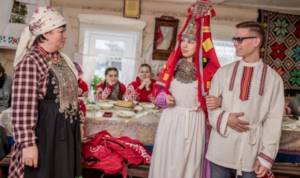
Wedding ceremony
The ceremonial rituals of marriage were conventionally divided into two parts. First, the holiday took place in the bride’s house, then everyone went together to the groom’s, where the rituals and feast continued. However, if the girl was taken away from her father’s house immediately after reaching an agreement, the celebration began with the newlywed’s parents.
Xuan - celebration at the bride's house
The groom's relatives equipped the wedding train, consisting of many horse-drawn carts. The train was decorated as richly as possible, including the harness. Ribbons, flowers, metal and precious monistas, and rings were tied. The groom was accompanied by the remaining relatives in the house, giving humorous and serious instructions. The poezzhans, as the participants in the procession were called, chose from among their number the most respected man who would lead the parade procession and officiate at the wedding. Demi's presence was mandatory.
The chosen one’s relatives did not take part in the trip. Their duty was to help organize the feast, meet and treat the guests. The house was luxuriously decorated for the arrival of guests. All accessible surfaces were covered with ceremonial tablecloths and tapestries, windows and mirrors were framed with embroidered towels. Pickles, cold meat, bread and homemade cakes were served on the table.
Travelers were greeted at the gate, offered a drink from the threshold - kumyshka, a national strong drink, flat cakes or brushwood. Anyone who didn’t take at least a bite was not allowed into the yard. The leaders of the celebrations were introduced and then seated at the table. Long songs began until the very end of the feast. It was in the songs that all the advantages of the bride and groom were described, thus introducing the newlyweds to each other and new relatives. Having sung everything that could be said about the newlyweds, the guests and hosts sang farewell songs and gathered the bride. Prepared gifts were presented.

Yarashon - celebration in the groom's house
Yarashon was prescribed, as a rule, after several days or weeks. If Xuan was celebrated at Christmas, then the next stage was scheduled for Maslenitsa. The festive cortege was supposed to visit the homes of relatives and respected people, and they always stopped by the wedding planner. In every house they were treated to a treat, they were taught ritual songs, and they were given instructions for a prosperous life. At the same time, the newlyweds did not perform any songs themselves.
Somewhere during the trip, the newlywed disappeared. The inconsolable groom had to find her. The feast continued at the groom's house. When a girl entered the territory, a pillow was thrown at her feet - so that her character would be soft and accommodating.
The final day of the celebration was marked by a masquerade. The more bizarre the image presented, the merrier. The residents said goodbye to the newlyweds, trying with all their might to bring the young woman to tears. It was considered a good omen that if she cried, the less sorrow she would have in the future.

The wedding night
The chosen one was met by her mother-in-law and escorted to the women's quarters. There she unbraided her girl’s braid, did a woman’s hairstyle and put on a turban, which from now on the married woman had to wear all the time. After this, the newlyweds were left for their first wedding night, with a canopy woven by the bride wrapped around their bed.
Interesting customs of the Udmurt wedding
Each nation has its own original small customs and signs regarding marriage. The Udmurts are no exception.
- Matchmakers had to carry selected snuff with them. If the father of the bride likes him, the consent is in his pocket.
- Both parents were not supposed to take part in matchmaking, only the father or older relative, and in their absence, the mother.
- One of the original customs of the Udmurts is the opportunity to take the arranged bride to the groom’s house immediately after the matchmaking is over.
- The girl herself had to embroider the canopy that covered the newlyweds’ bed.
- In order for the newlyweds to be released from the house of the girl's parents, the groom had to pay a ransom.
- When the bride was preparing tabani - yeast pancakes in the groom's house, the groom's groomsmen disturbed her in every possible way, closing the dampers in the oven, turning the work into a fun game. To stop the outrage, the guys were given drinks.
- The main rituals were the dressing of the bride in her husband's house, when she was dressed in a woman's headscarf, and bathing, when the girl was doused with water from buckets the morning after her wedding night.
- The owners of the house could demand a barrel of kumyshka, and the same one that was made for the birth of the newlywed.
All customs at an Udmurt wedding had a deep ritual significance, or contributed to the creation of the necessary mood. Still, the transition from one family to another is a very difficult period.
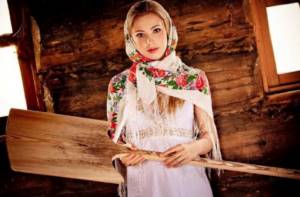
National costume of the Udmurts
Udmurtia became known throughout the world thanks to the triumphant performance of the group “Buranovskie Babushki” at Eurovision. The performers were dressed in traditional women's clothing of their people. Please note that this is an extremely interesting and complex outfit that today Udmurts like to wear during folk holidays and festivities.
The Udmurt costume is a tunic-like shirt, over which women wore a white robe. In winter they wore a camisole on top, and on holidays they preferred to wear a snow-white outfit.
A distinctive feature is a cap embroidered with coins. In general, the Udmurt women’s costume contains an abundance of coins, beads, and all kinds of jewelry. Often the necks of Udmurtian beauties are also decorated with a necklace of sparkling coins.
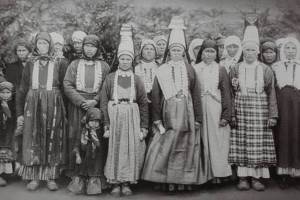
Udmurts
Entering a new life
In the morning, the tests of the newly-made wife began. She had to demonstrate her dowry, which her new relatives meticulously assessed. And also - to convince everyone of your culinary and household skills. The girl had to prepare a meal for guests and relatives on her husband’s side and complete household tasks. Then everyone went to the river, where the ritual of ablution was performed, the young woman threw a silver coin into the water and drew water. This water was used to prepare food for the guests.
The bride's relatives could visit the bride only a few days later. The young wife could not even visit her parents without being accompanied by her husband or mother-in-law. The following months after the wedding were marked by visits to numerous relatives. This is how the young wife was introduced to her new relatives. The cattle intended for the dowry were collected in the first autumn after the wedding. And this action completed the wedding ritual.

